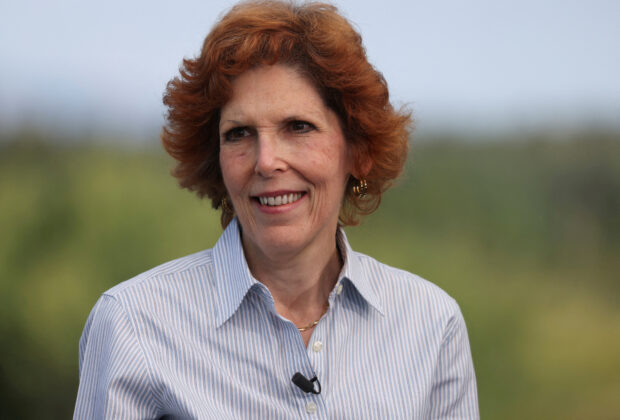
Loretta J. Mester, president and CEO of the Federal Reserve Bank of Cleveland, looks on at Teton National Park where financial leaders from around the world gathered for the Jackson Hole Economic Symposium outside Jackson, Wyoming, U.S., Aug 26, 2022. REUTERS/Jim Urquhart/File photo
A pair of Federal Reserve policymakers often considered to have divergent monetary policy leanings on Tuesday both said they think it would be “reasonable” to cut U.S. interest rates three times this year, even as stronger recent economic data has sown investor doubts about that outcome.
Cleveland Fed Bank President Loretta Mester and San Francisco Fed Bank President Mary Daly last month joined the U.S. central bank’s unanimous vote to leave short-term interest-rates in the 5.25 percent-5.5 percent range to keep putting downward pressure on inflation.
“At this point, the economy and policy are in a good place,” Daly said at an event in Las Vegas. “Inflation is coming down, but it’s slow, it’s bumpy and slow. The labor market is still going strong and growth is going strong. So there’s really no urgency to adjust the rate.”
Projections published at the Fed’s March meeting showed the typical policymaker expected to deliver three quarter-point interest rate cuts this year, though nearly half of officials – nine of the 19 – see two or less this year, according to forecasts issued last month.
READ: Federal Reserve still foresees 3 interest rate cuts in 2024
“I think that is a very reasonable baseline,” said Daly, often pegged as dovish though a self-described policy centrist.
Still, Daly said, there is a “real risk” of cutting rates too soon and locking in the “toxic tax” of too-high inflation.
Mester, on the more hawkish end of the Fed’s policy spectrum, told reporters on Tuesday that three rate cuts for this year remain a “reasonable” forecast while deeming it a “close call.”
Though, like Daly, she acknowledged the risk of keeping rates high for too long and unnecessarily harming the labor market, “at this point, I think the bigger risk would be to begin reducing the funds rate too early,” Mester said at an event in Cleveland.
Federal Reserve Bank of San Francisco President Mary Daly poses for a photograph at the Kansas City Federal Reserve Bank’s annual Economic Policy Symposium in Jackson Hole, Wyoming, U.S. Aug 25, 2023. REUTERS/Ann Saphir/File photo
No change in view despite inflation print
Inflation by the Fed’s targeted measure was 2.5 percent in February, far below its mid-2022 peak of around 7 percent but still above the 2 percent goal, with progress slower so far this year than for much of last year. Meanwhile the labor market has been strong, with unemployment at 3.9 percent in February.
READ: US manufacturing recovering; raw material prices pose challenge
Data this week showed manufacturing unexpectedly rebounding, with a rise in raw materials prices raising fears that inflation could resurge.
Investors are eager to hear how Fed Chair Jerome Powell, speaking at Stanford University on Wednesday, adds it all up. They are also focused on whether the next monthly read on the U.S. labor market, due on Friday, backs up other data suggesting the labor market is cooling, and if fresh inflation reads ahead of the Fed’s next two meetings, April 30-May 1 and June 11-12, show prices are as well.
Powell, speaking last Friday, said the stronger-than-expected inflation readings so far this year have not changed his overall view that inflation is headed downward and the Fed will cut rates later this year.
Financial markets are betting heavily against a May 1 rate cut. Mester on Tuesday said she does not think there will be enough information between now and then to justify it.
But that could change by June, Mester said.
“We have to be data dependent so I don’t want to rule that out,” Mester told reporters after her speech.
Interest-rate futures prices currently imply about a 65-percent chance of a rate hike by June, down from about 70 percent after the Fed’s March meeting.